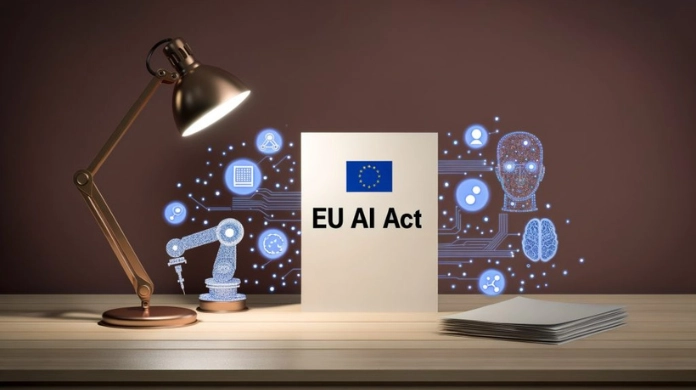The regulation, designed to govern AI use across the EU with the goal of mitigating risks, increasing transparency, and safeguarding fundamental rights, officially came into force in August 2024. Since then, it has been rolling out in phases, with the latest stage imposing governance obligations on developers and users of general-purpose AI systems such as ChatGPT. These new requirements include transparency measures, technical documentation, and incident reporting protocols. Meanwhile, heavy fines are on the table for those who fail to comply.
Although more than 45 European tech firms called upon the EU to pause the implementation, citing concerns over regulatory complexity and threats to European competitiveness, the European Commission has firmly committed to continuing the rollout on schedule to foster trustworthy AI ecosystems.
EU AI Act: Phased Rollout to Manage AI Risks and Protection
The AI Act publication in the Official Journal of the European Union on July 12, 2024, marked the beginning of a 24-month transition period allowing businesses and regulatory authorities to prepare for compliance. By February 2, 2025, the Act banned AI systems considered to pose “unacceptable risks,” such as social scoring tools deployed by governments. This phase also launched mandatory AI literacy requirements for organizations handling AI technology.
The latest and most significant phase began on August 2, 2025, introducing new rules revolving around providers and deployers of general-purpose artificial intelligence systems. This includes demands for clear disclosure when AI is used, comprehensive technical documentation outlining system design and training data (including copyrighted content), and strict incident reporting systems aimed at swiftly addressing AI-related failures or harms. National governments were also tasked with appointing enforcement authorities to supervise market conformity and surveillance ahead of this deadline.
Looking ahead, by August 2, 2026, companies operating high-risk AI systems — those deployed in sensitive sectors such as biometrics, infrastructure, recruitment, or education — must fully meet a broader set of regulatory requirements. The entire regulatory regime will be fully operational by August 2027, when additional safety protocols for high-risk AI systems come into effect.
Industry Pushback and Regulatory Resolve
The tech sector’s pushback against the AI Act’s rollout crystallized in early July 2025, when dozens of European tech firms publicly urged the EU to pause implementing regulations particularly impacting general-purpose and high-risk AI systems. These firms voiced concerns about the administrative hurdles, the rigidity of compliance requirements, and the potential stifling effect on European innovation and competitiveness — particularly versus global technology giants based outside the EU.
Despite these objections, the European Commission dismissed calls for delay, emphasizing the necessity of timely enforcement to mitigate the risks posed by AI technologies, including societal biases, inequalities, and safety risks. The Commission framed the Act as a crucial mechanism to bolster public trust in AI systems by instituting transparency, accountability, and robust safety nets at scale across the single market.
Enforcement, Penalties, and Governance Framework
From August 2025 onward, AI system providers and users must navigate a complex compliance landscape. Mandatory transparency means that any deployment of AI must be clearly communicated, and detailed system documentation must be maintained and provided to authorities when required. Systems trained on copyrighted material must disclose this fact to ensure intellectual property rights are respected. Furthermore, any incidents involving AI system failures or misuse must be promptly reported to regulatory bodies.
To ensure compliance is enforced rigorously, each EU member state must designate competent national authorities responsible for conformity assessments, market surveillance, and investigation of complaints. Alongside this framework, the EU is establishing a central coordinating body — the EU AI Office — to ensure harmonized enforcement and advice across member states.
Fines for non-compliance with the AI Act are significant, with penalties reaching up to €35 million or 7% of global annual turnover for deploying prohibited AI systems or violating essential safety requirements. Lesser but still substantial fines of up to €7.5 million or 1.5% of turnover apply for false declarations or neglecting reporting duties. These stiff penalties underscore the EU’s serious commitment to regulating AI effectively.
Broader Context: Preparing Europe for AI’s Future
The EU AI Act represents a pioneering global attempt to reconcile the rapid advance of AI technologies with the imperative to protect human rights and societal norms. The phased, multi-year implementation strategy is intended to provide the industry with ample time to adjust while maintaining pressure to adopt safe, transparent, and responsible AI practices.
That said, some aspects of the Act’s implementation have faced delays, such as the finalization of the Code of Practice for General Purpose AI systems, which is expected to provide detailed, practical guidance for providers. Divergent views among regulators, industry, and civil society continue to generate debate about the optimal calibration of regulation without hindering innovation.
The EU AI Act Sets a Bold Precedent in AI Governance
With the start of enforcement phases in 2025, the EU AI Act transitions from legislative ambition to practical application, setting a global benchmark for AI regulation. While technology companies continue to express concerns regarding certain regulatory measures, the European Commission’s commitment to the established timeline signals that strict regulation and oversight are here to stay.
As AI providers and organizations operating within the EU adapt to the new regime, they face complex compliance demands or risk attracting substantial penalties. Ultimately, the act aims to foster an AI ecosystem that is not only innovative but grounded in transparency, safety, and respect for fundamental rights.









